Use of SWOT Data for Hydrodynamic Modelling in a Tropical Microtidal Estuarine System: The Case of Casamance (Senegal)
Abstract
1. Introduction
2. Materials and Methods
2.1. Study Area
2.2. In Situ Data
2.3. TPOX8 Tidal Model
2.4. Delft3D Hydrodynamic Modelling
2.4.1. Model Configuration
2.4.2. Tidal Boundary Conditions
2.4.3. Turbulence Modelling and Vertical Flow Structure
2.5. SWOT Observation
2.5.1. SWOT L2_HR_PIXC Product Overview
2.5.2. Extraction of Water Levels and Estimation of Hydraulic Slopes
2.6. Conceptual Framework for Modelling and Validation
3. Results
3.1. Hydrodynamic Model of Delf3D-Flow Validation: Water Levels and Horizontal Flow
3.2. Validation of the Vertical Structure of the Delft3D-Flow Hydrodynamic Model
3.3. Comparison of Water Levels
3.4. Spatial Variation in Current Velocities in the Casamance Estuary
3.5. Bottom Shear Stress and Sediment Transport in the Main Channel of the Estuary
3.5.1. Situation MORFAC = 10
3.5.2. Situation MORFAC = 01
4. Discussion
4.1. Model Performance
4.2. Interest and Limitations of SWOT
4.3. Morphodynamic Sensitivity to the MORFAC Coefficient
4.4. Sediment Distribution Under the Influence of the Tide
4.5. Implication of Hydraulic Slope on the Dynamic Hydro-Morpho Process
5. Conclusions
Author Contributions
Funding
Data Availability Statement
Acknowledgments
Conflicts of Interest
Abbreviations
| ADCP | Acoustic Doppler Current Profiler |
| HFD | Height–Fall–Discharge |
| HW | High Water |
| LW | Low Water |
| LWS | Low Water Spring |
| MAE | Mean Absolute Error |
| MORFAC | Morphological Acceleration Factor |
| MHWS | Mean High Water Springs |
| MLWS | Mean Low Water Springs |
| RMSE | Root Mean Square Error |
| WSE | Water Surface Elevation |
| SWOT | Surface Water and Ocean Topography |
| NASA | National Aeronautics and Space Administration |
| CNES | Centre National d’Études Spatiales |
| CSA | Canadian Space Agency |
| UKSA | United Kingdom Space Agency |
Appendix A
| Instrument | Location | Depth (m) | Acquisition Period | Resolution (min) | Data |
|---|---|---|---|---|---|
| Aquadopp | ST3: Ziguinchor pontoon, 70 km upstream | 3 | 20 January–22 July 2023 | 10 | Current velocity and water level |
| ST1: Carabane pontoon downstream | 8 | 21 January–23 April 2023 | 10 | ||
| AWAC ADCP | ST0: 5 km from the mouth | 6 | 11 November–2 December 2012 | 15 | Current velocity (30 cells of 50 cm) and water level |
| AWAC ADCP | ST4: Mid-channel a Ziguinchor | 9 | 21–22 November 2021 | 1 | Current velocity (cells of 50 cm) and water level |
| ST2: Mid-channel Carabane | 14 | 23–24 November 2021 | 1 |

Appendix B
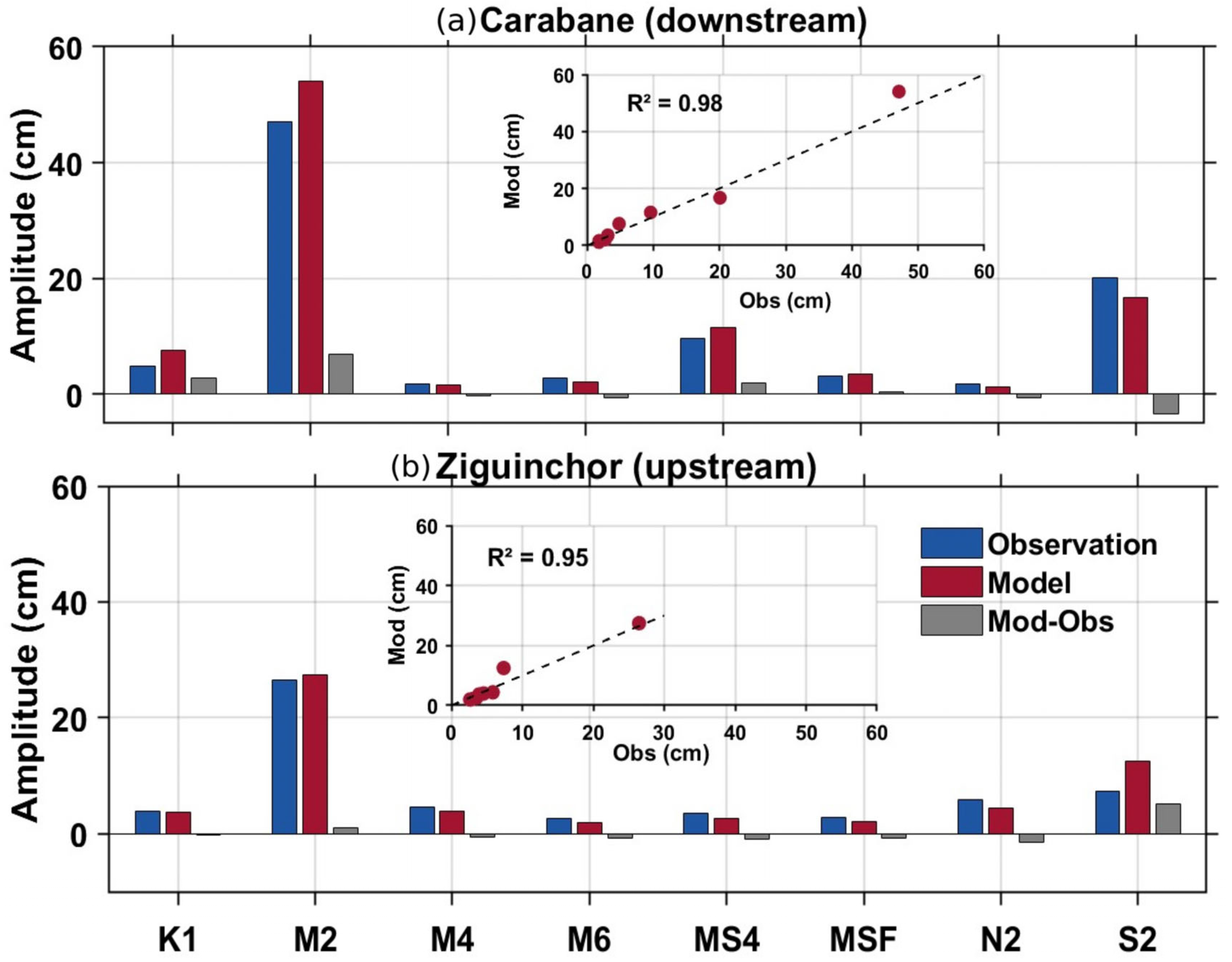

References
- Albergel, J. Une méthode «expert» pour la conception des barrages «antisel» dans les bas-fonds de Basse et Moyenne-Casamance. In Conservation et Utilisation Durable des Ressources Naturelles du Bassin Hydrographique de la Casamance; Grepin, G., Pomerleau, C., Pirot, J.-Y., Eds.; AJAC-ZG/ISRA/ORSTOM/UICN: Dakar, Senegal, 1992; pp. 75–82. [Google Scholar]
- Dacosta, H. Précipitations et écoulements sur le bassin de la Casamance. Ph.D. Thesis, Université Cheikh Anta Diop, Dakar, Senegal, 1989; 278p. [Google Scholar]
- Olivry, J.-C. Les conséquences durables de la sécheresse actuelle sur l’écoulement du fleuve Sénégal et l’hypersalinisation de la basse Casamance. In The Influence of Climate Change and Climatic Variability on the Hydrologie Regime and Water Resources; IAHS-AISH: Wallingford, UK, 1987; Volume 3, pp. 501–512. [Google Scholar]
- Montoroi, J.P.; Albergel, J. L’intervention des hydrologues et pédologues de l’ORSTOM en Casamance. In Conservation et Utilisation Durable des Ressources Naturelles du Bassin Hydrographique de la Casamance; Horizon: Dakar, Senegal, 1993; pp. 96–99. Available online: https://horizon.documentation.ird.fr (accessed on 10 December 2023).
- Bacci, M.; Diop, M.; Pasqui, M. Climat—Encadrement Climatique et Évaluation du Changement Climatique Dans les Régions D’étude; Rapport n°6, Programme d’Appui au Programme National D’Investissement en Agriculture du Sénégal (PAPSEN); PAPSEN: Dakar, Senegal, 2013; p. 152. Available online: http://www.papsen.org/data/files/PAPSEN_Climat_MB_low.pdf (accessed on 25 October 2023).
- Sadio, P.M.; Mbaye, M.L.; Diatta, S.; Sylla, M.B. Hydro-climate variability and change in the Casamance river basin (Senegal). Houille Blanche 2020, 106, 89–96. [Google Scholar] [CrossRef]
- Han, W.; Huang, C.; Gu, J.; Hou, J.; Zhang, Y.; Wang, W. Water Level Change of Qinghai Lake from ICESat and ICESat-2 Laser Altimetry. Remote Sens. 2022, 14, 6212. [Google Scholar] [CrossRef]
- Xu, K.; Wang, C.; Bin, L. Compound flood models in coastal areas: A review of methods and uncertainty analysis. Nat. Hazards 2022, 116, 469–496. [Google Scholar] [CrossRef]
- Yu, L.; Zhang, H.; Gong, W.; Ma, X. Validation of Mainland Water Level Elevation Products from SWOT Satellite. IEEE J. Sel. Top. Appl. Earth Obs. Remote Sens. 2024, 17, 13494–13505. [Google Scholar] [CrossRef]
- Wang, H.; Chu, Y.; Huang, Z.; Hwang, C.; Chao, N. Robust, long-term lake level change from multiple satellite altimeters in Tibet: Observing the rapid rise of Ngangzi Co over a new wetland. Remote Sens. 2019, 11, 558. [Google Scholar] [CrossRef]
- Oubanas, H.; Gejadze, I.; Malaterre, P.O.; Mercier, F. River discharge estimation from synthetic SWOT-type observations using variational data assimilation and the full Saint-Venant hydraulic model. J. Hydrol. 2018, 559, 638–647. [Google Scholar] [CrossRef]
- Ramillien, G.; Frappart, F.; Seoane, L. Application of the regional water mass variations from GRACE satellite gravimetry to large-scale water management in Africa. Remote Sens. 2014, 6, 7379–7405. [Google Scholar] [CrossRef]
- Taveneau, A.; Almar, R.; Bergsma, E.W.J.; Sy, B.A.; Ndour, A.; Sadio, M.; Garlan, T. Observing and predicting coastal erosion at the langue de barbarie sand spit around saint louis (Senegal, west africa) through satellite-derived digital elevation model and shoreline. Remote Sens. 2021, 13, 2454. [Google Scholar] [CrossRef]
- Angnuureng, D.B.; Brempong, K.; Jayson-Quashigah, P.; Dada, O.; Akuoko, S.; Frimpomaa, J.; Mattah, P.; Almar, R. Satellite, drone and video camera multi-platform monitoring of coastal erosion at an engineered pocket beach: A showcase for coastal management at Elmina Bay, Ghana (West Africa). Reg. Stud. Mar. Sci. 2022, 53, 102437. [Google Scholar] [CrossRef]
- Mendoza, E.T.; Salameh, E.; Sakho, I.; Turki, I.; Almar, R.; Ojeda, E.; Deloffre, J.; Frappart, F.; Laignel, B. Coastal flood vulnerability assessment, a satellite remote sensing and modeling approach. Remote Sens. Appl. 2023, 29, 100923. [Google Scholar] [CrossRef]
- Almar, R.; Bergsma, E.W.J.; Maisongrande, P.; de Almeida, L.P.M. Wave-derived coastal bathymetry from satellite video imagery: A showcase with Pleiades persistent mode. Remote Sens. Environ. 2019, 231, 111263. [Google Scholar] [CrossRef]
- Bergsma, E.W.J.; Almar, R.; Anthony, E.J.; Garlan, T.; Kestenare, E. Wave variability along the world’s continental shelves and coasts: Monitoring opportunities from satellite Earth observation. Adv. Space Res. 2022, 69, 3236–3244. [Google Scholar] [CrossRef]
- Almar, R.; Kestenare, E.; Reyns, J.; Jouanno, J.; Anthony, E.; Laibi, R.; Hemer, M.; Du Penhoat, Y.; Ranasinghe, R. Response of the Bight of Benin (Gulf of Guinea, West Africa) coastline to anthropogenic and natural forcing, Part1: Wave climate variability and impacts on the longshore sediment transport. Cont. Shelf Res. 2015, 110, 48–59. [Google Scholar] [CrossRef]
- Anthony, E.J.; Almar, R.; Besset, M.; Reyns, J.; Laibi, R.; Ranasinghe, R.; Ondoa, G.A.; Vacchi, M. Response of the Bight of Benin (Gulf of Guinea, West Africa) coastline to anthropogenic and natural forcing, Part 2: Sources and patterns of sediment supply, sediment cells, and recent shoreline change. Cont. Shelf Res. 2019, 173, 93–103. [Google Scholar] [CrossRef]
- Diouf, A.; Cissé, C.O.T.; Almar, R.; Sy, B.; Sy, B.A.; Taveneau, A.; Sakho, I.; Sow, B.A.; Ondoa, G.A.; Ndour, A.; et al. Urban beach evolution in Saint Louis, Senegal (West Africa) using shore-based camera video monitoring as a management tool. Reg. Stud. Mar. Sci. 2025, 83, 104050. [Google Scholar] [CrossRef]
- Klotz, A.N.; Almar, R.; Quenet, Y.; Bergsma, E.W.; Youssefi, D.; Artigues, S.; Rascle, N.; Sy, B.A.; Ndour, A. Nearshore satellite-derived bathymetry from a single-pass satellite video: Improvements from adaptive correlation window size and modulation transfer function. Remote Sens. Environ. 2024, 315, 114411. [Google Scholar] [CrossRef]
- Marchesiello, P.; Thoumyre, G.; Dieye, A.; Almar, R.; Bergsma, E.; Sow, B.A.; Duong, H.T. Exploring Fine-Scale Satellite-Derived Coastal Bathymetry for Ocean Modeling: A Case Study from West Africa. Estuaries Coasts 2024, 47, 2696–2712. [Google Scholar] [CrossRef]
- Pajak, K.; Idzikowska, M.; Kowalczyk, K. Relationship of Satellite Altimetry Data, and Bathymetry Observations on the West Coast of Africa. J. Mar. Sci. Eng. 2023, 11, 149. [Google Scholar] [CrossRef]
- Angnuureng, D.B.; Almar, R.; Addo, K.A.; Castelle, B.; Senechal, N.; Laryea, S.W.; Wiafe, G. Video oberservation of waves and shoreline change on the microtidal james town beach in Ghana. J. Coast. Res. 2016, 75, 1022–1026. [Google Scholar] [CrossRef]
- Almar, R.; Stieglitz, T.; Addo, K.A.; Ba, K.; Ondoa, G.A.; Bergsma, E.W.J.; Bonou, F.; Dada, O.; Angnuureng, D.; Arino, O. Coastal Zone Changes in West Africa: Challenges and Opportunities for Satellite Earth Observations. Surv. Geophys. 2023, 44, 249–275. [Google Scholar] [CrossRef]
- Ondoa, G.A.; Almar, R.; Castelle, B.; Testut, L.; Léger, F.; Sohou, Z.; Bonou, F.; Bergsma, E.W.J.; Meyssignac, B.; Larson, M. Sea level at the coast from video-sensed waves: Comparison to tidal gauges and satellite altimetry. J. Atmos. Ocean. Technol. 2019, 36, 1591–1603. [Google Scholar] [CrossRef]
- Dièye, A.; Sow, B.A.; Dieng, H.B.; Marchesiello, P.; Descroix, L. Impact of climate variability modes on trend and interannual variability of sea level near the West African coast. Afr. J. Environ. Sci. Technol. 2023, 17, 157–166. [Google Scholar] [CrossRef]
- Cisse, C.O.T.; Brempong, E.K.; Taveneau, A.; Almar, R.; Sy, B.A.; Angnuureng, D.B. Extreme coastal water levels with potential flooding risk at the low-lying Saint Louis historic city, Senegal (West Africa). Front. Mar. Sci. 2022, 9, 1–12. [Google Scholar] [CrossRef]
- Duncan, C.; Owen, H.J.F.; Thompson, J.R.; Koldewey, H.J.; Primavera, J.H.; Pettorelli, N. Satellite remote sensing to monitor mangrove forest resilience and resistance to sea level rise. Methods Ecol. Evol. 2018, 9, 1837–1852. [Google Scholar] [CrossRef]
- Birkett, C.M.; Mertes, L.A.K.; Dunne, T.; Costa, M.H.; Jasinski, M.J. Surface water dynamics in the Amazon Basin: Application of satellite radar altimetry. J. Geophys. Res. Atmos. 2002, 107, LBA 26-1–LBA 26-21. [Google Scholar] [CrossRef]
- Frappart, F.; Calmant, S.; Cauhopé, M.; Seyler, F.; Cazenave, A. Preliminary results of ENVISAT RA-2-derived water levels validation over the Amazon basin. Remote Sens. Environ. 2006, 100, 252–264. [Google Scholar] [CrossRef]
- Diepkilé, A.T.; Egon, F.; Blarel, F.; Mougin, E.; Frappart, F. Validation of the altimetry-based water levels from Sentinel-3A and B in the Inner Niger Delta. In Proceedings of the International Association of Hydrological Sciences; Copernicus GmbH: Göttingen, Germany, 2021; pp. 31–35. [Google Scholar] [CrossRef]
- Bogning, S.; Frappart, F.; Blarel, F.; Niño, F.; Mahé, G.; Bricquet, J.-P.; Seyler, F.; Onguéné, R.; Etamé, J.; Paiz, M.-C.; et al. Monitoring water levels and discharges using radar altimetry in an ungauged river basin: The case of the Ogooué. Remote Sens. 2018, 10, 350. [Google Scholar] [CrossRef]
- Papa, F.; Frappart, F.; Malbeteau, Y.; Shamsudduha, M.; Vuruputur, V.; Sekhar, M.; Ramillien, G.; Prigent, C.; Aires, F.; Pandey, R.K.; et al. Satellite-derived surface and sub-surface water storage in the Ganges-Brahmaputra River Basin. J. Hydrol. Reg. Stud. 2015, 4, 15–35. [Google Scholar] [CrossRef]
- Zhao, Y.; Fu, J.; Pang, Z.; Jiang, W.; Zhang, P.; Qi, Z. Validation of Inland Water Surface Elevation from SWOT Satellite Products: A Case Study in the Middle and Lower Reaches of the Yangtze River. Remote Sens. 2025, 17, 1330. [Google Scholar] [CrossRef]
- Tourian, M.J.; Elmi, O.; Mohammadnejad, A.; Sneeuw, N. Estimating river depth from SWOT-type observables obtained by satellite altimetry and imagery. Water 2017, 9, 753. [Google Scholar] [CrossRef]
- Wongchuig-Correa, S.; de Paiva, R.C.D.; Biancamaria, S.; Collischonn, W. Assimilation of future SWOT-based river elevations, surface extent observations and discharge estimations into uncertain global hydrological models. J. Hydrol. 2020, 590, 125473. [Google Scholar] [CrossRef]
- Altenau, E.H.; Pavelsky, T.M.; Durand, M.T.; Yang, X.; Frasson, R.P.d.M.; Bendezu, L. The Surface Water and Ocean Topography (SWOT) Mission River Database (SWORD): A Global River Network for Satellite Data Products. Water Resour. Res. 2021, 57, e2021WR030054. [Google Scholar] [CrossRef]
- Normandin, C.; Frappart, F.; Baghdadi, N.; Bourrel, L.; Luque, S.P.; Ygorra, B.; Kitambo, B.; Papa, F.; Riazanoff, S.; Wigneron, J.-P.; et al. First results of the surface water ocean topography (SWOT) observations to rivers elevation profiles in the Cuvette Centrale of the Congo Basin. Front. Remote Sens. 2024, 5, 1466695. [Google Scholar] [CrossRef]
- Bergeron, J.; Siles, G.; Leconte, R.; Trudel, M.; Desroches, D.; Peters, D.L. Assessing the capabilities of the Surface Water and Ocean Topography (SWOT) mission for large lake water surface elevation monitoring under different wind conditions. Hydrol. Earth Syst. Sci. 2020, 24, 5985–6000. [Google Scholar] [CrossRef]
- Amaral, F.R.D.; Pellarin, T.; Trung, T.N.; Tu, T.A.; Gratiot, N. Enhancing discharge estimation from SWOT satellite data in a tropical tidal river environment. PLOS Water 2024, 3, e0000226. [Google Scholar] [CrossRef]
- Bonassies, Q.; Nguyen, T.H.; Cassan, L.; Piacentini, A.; Ricci, S.; Emery, C.; Fatras, C.; Luque, S.P.; Suquet, R.R. Assimilation of SWOT Altimetry Data for Riverine Flood Reanalysis: From Synthetic to Real Data. arXiv 2025, arXiv:2504.21670. [Google Scholar] [CrossRef]
- Bôas, A.B.V.; Marechal, G.; Bohé, A. Observing Interactions Between Waves, Winds, and Currents from SWOT. Geophys. Res. Lett. 2024, 52, e2024GL114331. [Google Scholar] [CrossRef]
- Archer, M.; Wang, J.; Klein, P.; Dibarboure, G.; Fu, L.L. Wide-swath satellite altimetry unveils global submesoscale ocean dynamics. Nature 2025, 640, 691–696. [Google Scholar] [CrossRef] [PubMed]
- Brunet-Moret, Y. Etude des marées dans le fleuve Casmance. Cah. Orstom Série Hydrol. 1970, 7, 3–18. [Google Scholar]
- Lahoud, A. Modélisation des Circulations Transitoire et Résiduelle: Application à L’estuaire de la Casamance (Sénégal). Ph.D. Thesis, Universite des Sciences et Techniques du Languedocc, Montpellier, France, 1989. [Google Scholar]
- Diouf, A.; Sakho, I.; Sow, B.A.; Deloffre, J.; Seujip, M.S.; Diouf, M.B.; Lafite, R. The Influence of Tidal Distortion on Extreme Water Levels in Casamance Estuary, Senegal. Estuaries Coasts 2025, 48, 42. [Google Scholar] [CrossRef]
- Ndom, B.; Ndoye, S.; Sow, B.A.; Echevin, V. Tides in the Casamance estuary: A modeling study. Cont. Shelf Res. 2025, 285, 105389. [Google Scholar] [CrossRef]
- Diouf, P.S.; Pagès, J.; Saos, J.L. Géographie de L’estuaire de la Casamance. In L’estuaire de la Casamance: Environnement, Pêche, Socioéconomie; ISRA/CRODT: Dakar, Senegal, 1986; pp. 13–22. [Google Scholar]
- Badji, Y.; Diankha, O.; Sow, B.A. Study of heavy metal contamination of Sarotherodon melanotheron and Crassostrea gasar in Casamance river (Senegal). Int. J. Biol. Chem. Sci. 2025, 19, 48–57. [Google Scholar] [CrossRef]
- Ndiaye, A.; Mbaye, T.; Ngom, D.; Ly, M.O.; Diouf, D. Fonctionnement Hydrique du Baobab (Adansonia digitata L.) en Moyenne et Haute Casamance (Sénégal). Eur. Sci. J. ESJ 2019, 15, 292. [Google Scholar] [CrossRef]
- Faye, C. Analyse des Tendances de la Distribution Régionale et de L’intensité des Précipitations: Utilisation D’indices Climatiques Dans le Bassin de la Casamance (Sénégal). Rivières du Sud 2018. Available online: http://rivieresdusud.uasz.sn (accessed on 5 June 2024).
- Diop, E.H.S.; Saos, J.L. Evidence of dynamics reversal in tropical estuaries, geomorphological and sedimentological consequences (Salum and Casamance Rivers, Senegal). Sedimentology 1985, 32, 543–552. [Google Scholar] [CrossRef]
- Saos, J.-L.; Le Bouteiller, C.; Diop, E.S. Introduction à l’étude sédimentologique et bathymétrique de la Casamance. In Études des Estuaires et Lagunes du Sénégal: Casamance et Joal-Fadiouth: Rapport Final; Université Cheikh Anta Diop: Dakar, Senegal, 1986; pp. 35–56. [Google Scholar]
- Egbert, G.D.; Erofeeva, S.Y. Efficient inverse modeling of barotropic ocean tides. J. Atmos. Ocean. Technol. 2002, 19, 183–204. [Google Scholar] [CrossRef]
- Egbert, G.D.; Ray, R.D.; Bills, B.G. Numerical modeling of the global semidiurnal tide in the present day and in the last glacial maximum. J. Geophys. Res. Ocean. 2004, 109, 1–15. [Google Scholar] [CrossRef]
- Stammer, D.; Ray, R.D.; Andersen, O.B.; Arbic, B.K.; Bosch, W.; Carrère, L.; Cheng, Y.; Chinn, D.S.; Dushaw, B.D.; Egbert, G.D.; et al. Accuracy assessment of global barotropic ocean tide models. Rev. Geophys. 2014, 52, 243–282. [Google Scholar] [CrossRef]
- Kresning, B.; Hashemi, M.R.; Neill, S.P.; Green, J.A.M.; Xue, H. The impacts of tidal energy development and sea-level rise in the Gulf of Maine. Energy 2019, 187, 115942. [Google Scholar] [CrossRef]
- Fu, H.; Dan, B.; Gao, Z.; Wu, X.; Chao, G.; Zhang, L.; Zhang, Y.; Liu, K.; Zhang, X.; Li, W. Global ocean reanalysis CORA2 and its inter comparison with a set of other reanalysis products. Front. Mar. Sci. 2023, 10, 1084186. [Google Scholar] [CrossRef]
- Cao, Y.; Zhang, W.; Zhu, Y.; Ji, X.; Xu, Y.; Wu, Y.; Hoitink, A. Impact of trends in river discharge and ocean tides on water level dynamics in the Pearl River Delta. Coast. Eng. 2020, 157, 103634. [Google Scholar] [CrossRef]
- Yu, X.; Zhang, W.; Hoitink, A.J.F. Impact of river discharge seasonality change on tidal duration asymmetry in the Yangtze River Estuary. Sci. Rep. 2020, 10, 6304. [Google Scholar] [CrossRef]
- WL|Delft Hydraulics. Delft3D-FLOW—Simulation of Multi-Dimensional Hydrodynamic Flows and Transport Phenomena, Including Sediments—User Manual. Delft, The Netherlands. 2011. Available online: www.deltares.nl (accessed on 14 September 2025).
- Boudet, L. Modélisation du Transport Sédimentaire Lié Aux Tempêtes et Aux Crues à L’embouchure du Rhône; AMU—Aix Marseille Université: Marseille, France, 2017; p. 224. [Google Scholar]
- Elias, E.P.L.; Walstra, D.J.R.; Roelvink, J.A.; Stive, M.J.F.; Klein, M.D. Hydrodynamic validation of Delft3D with field measurements at Egmond. Coast. Eng. 2000, 2001, 2714–2727. [Google Scholar]
- Lesser, G.R.; Roelvink, J.A.V.; van Kester, J.A.T.M.; Stelling, G.S. Development and validation of a three-dimensional morphological model. Coast. Eng. 2004, 51, 883–915. [Google Scholar] [CrossRef]
- Luijendijk, A.P. Validation, Calibration and Evaluation of Delft3D-FLOW Model with Ferry Measurements. Master’s Thesis, TU Delft, Delft, The Netherlands, 2001. [Google Scholar]
- Mohammadian, A.; Ghobrial, T.R. Two-dimensional numerical modelling of ice-jam flood in the Chaudière River using Delft3D-FLOW-Ice. In Proceedings of the 26 IAHR International Symposium on Ice, Montréal, QC, Canada, 23 June 2022. [Google Scholar]
- Ruessink, B.G.; Ramaekers, G.; Van Rijn, L.C. On the parameterization of the free-stream non-linear wave orbital motion in nearshore morphodynamic models. Coast. Eng. 2012, 65, 56–63. [Google Scholar] [CrossRef]
- Wang, Z.B.; Jeuken, M.C.J.L.; Gerritsen, H.; De Vriend, H.J.; Kornman, B.A. Morphology and asymmetry of the vertical tide in the Westerschelde estuary. Cont. Shelf Res. 2002, 22, 2599–2609. [Google Scholar] [CrossRef]
- Systems, D. 3D/2D Modelling Suite for Integral Water Solutions, DELFT3D-FLOW; Deltares: Delft, The Netherlands, 2024; pp. 1–110. [Google Scholar]
- Stelling, G.S.; Van Kester, J.A.T.M. On the approximation of horizontal gradients in sigma co-ordinates for bathymetry with steep bottom slopes. Int. J. Numer. Methods Fluids 1994, 18, 915–935. [Google Scholar] [CrossRef]
- Brak, R.; Cordier, S.; Jillings, T. Development of the Port of Ziguinchor. Draft Report 9W2100.R004, Agence Nationale des Affaires Maritimes. Draft report 9W2100.R004, Agence Nationale des Affaires Maritimes. 2013. Available online: https://www.rvo.nl/subsidies-regelingen/projecten/development-port-ziguinchor (accessed on 22 February 2022).
- Lesser, G.R. An Approach to Medium-Term Coastal Morphological Modelling; CRC Press/Balkema: Boca Raton, FL, USA, 2009; 201p, Available online: https://unesdoc.unesco.org/ark:/48223/pf0000188059 (accessed on 20 November 2024)ISBN 978-0-415-55668-2.
- Surface Water Ocean Topography (SWOT). SWOT Level 2 Water Mask Pixel Cloud Auxiliary Data Product; Version C. Ver. C. PO.DAAC: Pasadena, CA, USA. Available online: https://podaac.jpl.nasa.gov/dataset/SWOT_L2_HR_PIXCVec_2.0 (accessed on 20 November 2024).
- SWOT Project. SWOT Calibration/Validation Plan (Initial Release). 2018. Available online: https://swot.jpl.nasa.gov/documents/2244/ (accessed on 15 November 2024).
- Amaral, F.R.D.; Trung, T.N.; Pellarin, T.; Gratiot, N. Challenging SWOT: Early assessment of level 2 high-rate river products in an urbanized, low elevation coastal zone. IEEE Geosci. Remote Sens. Lett. 2024, 22, 1–5. [Google Scholar] [CrossRef]
- Amaral, F.R.D.; Gratiot, N.; Pellarin, T.; Tu, T.A. Assessing typhoon-induced compound flood drivers: A case study in Ho Chi Minh City, Vietnam. Nat. Hazards Earth Syst. Sci. 2023, 23, 3379–3405. [Google Scholar] [CrossRef]
- Surface Water and Ocean Topography (SWOT) Project Release Note Version C KaRIn Science Data Products. 2024. Available online: https://www.google.com.hk/url?sa=t&source=web&rct=j&opi=89978449&url=https://www.aviso.altimetry.fr/fileadmin/documents/data/tools/SWOT_VersionC_KaRIn_Products_Release_Note_20241014.pdf&ved=2ahUKEwj8l_iZk-SPAxVRZvUHHRuJDqQQFnoECBoQAQ&usg=AOvVaw1IMsV7IoVcgINeCVnplgct (accessed on 20 November 2024).
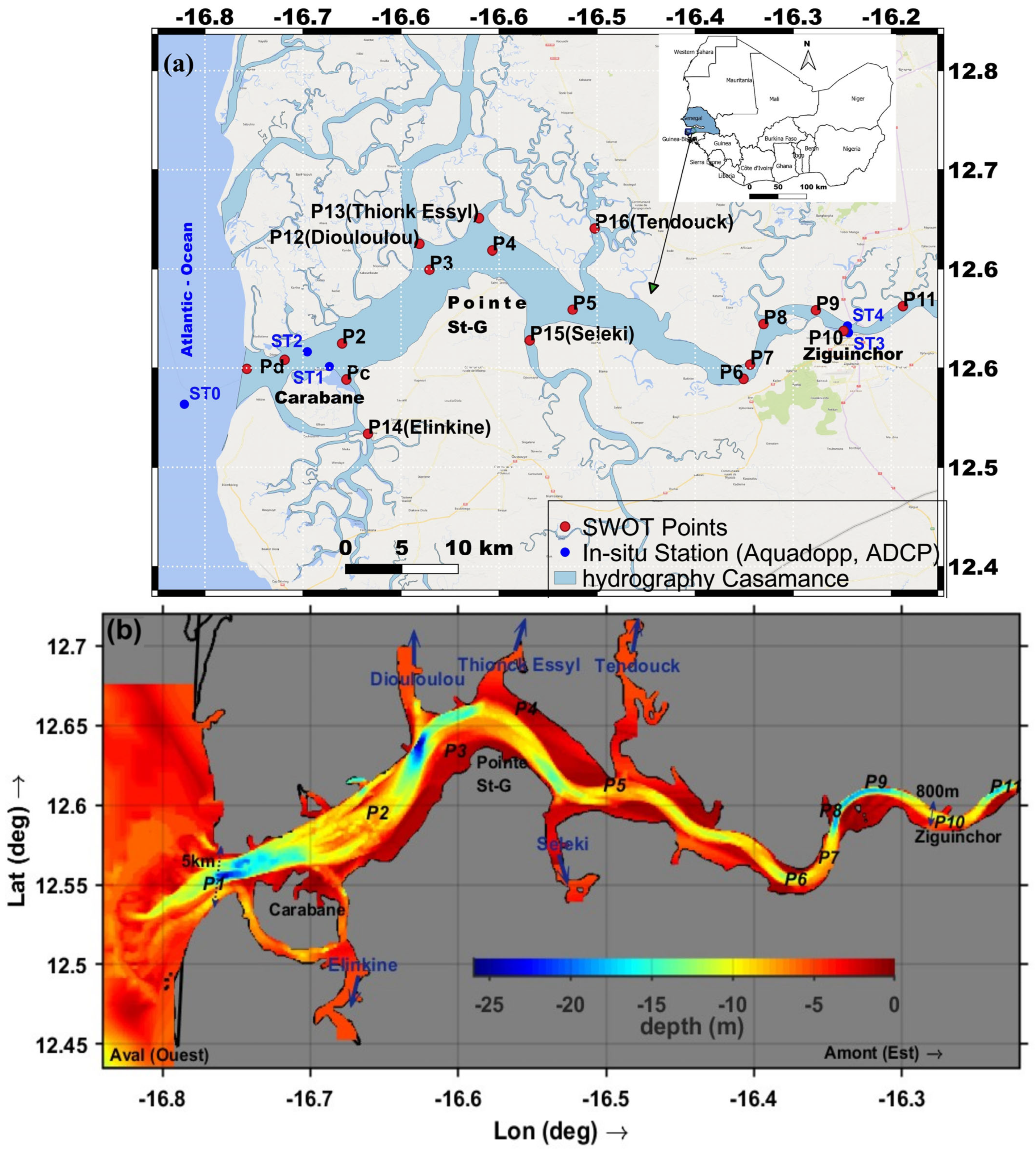
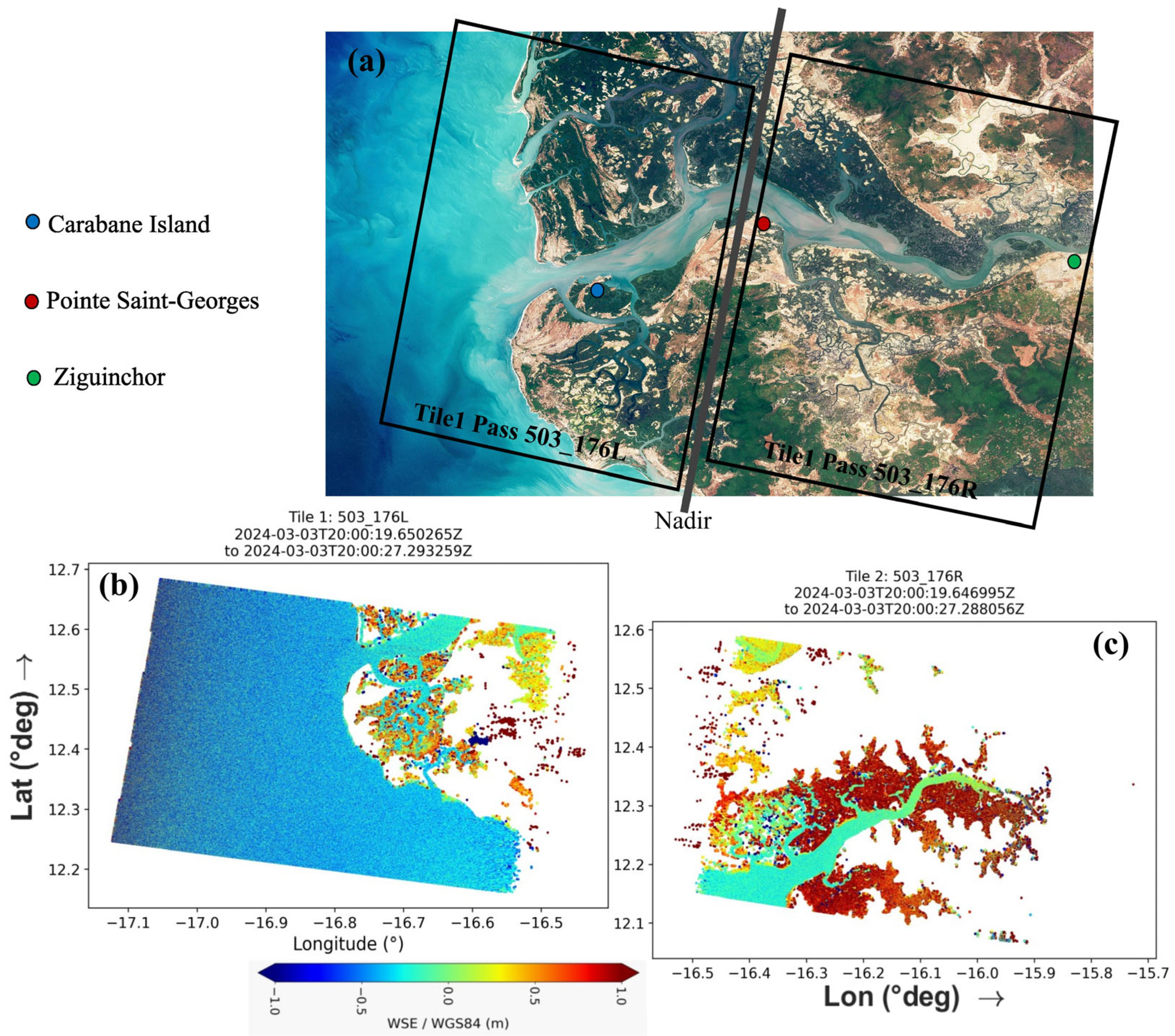
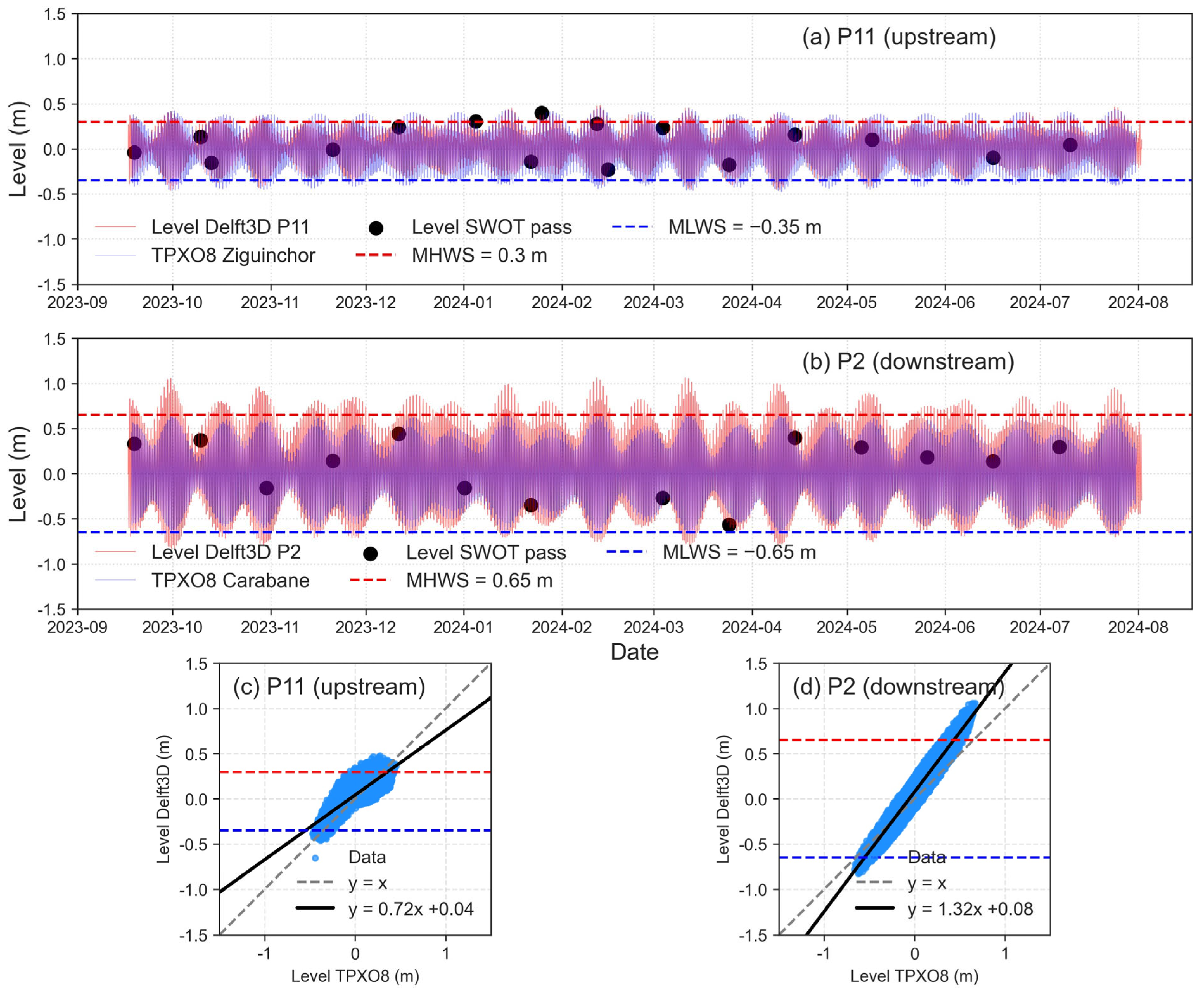
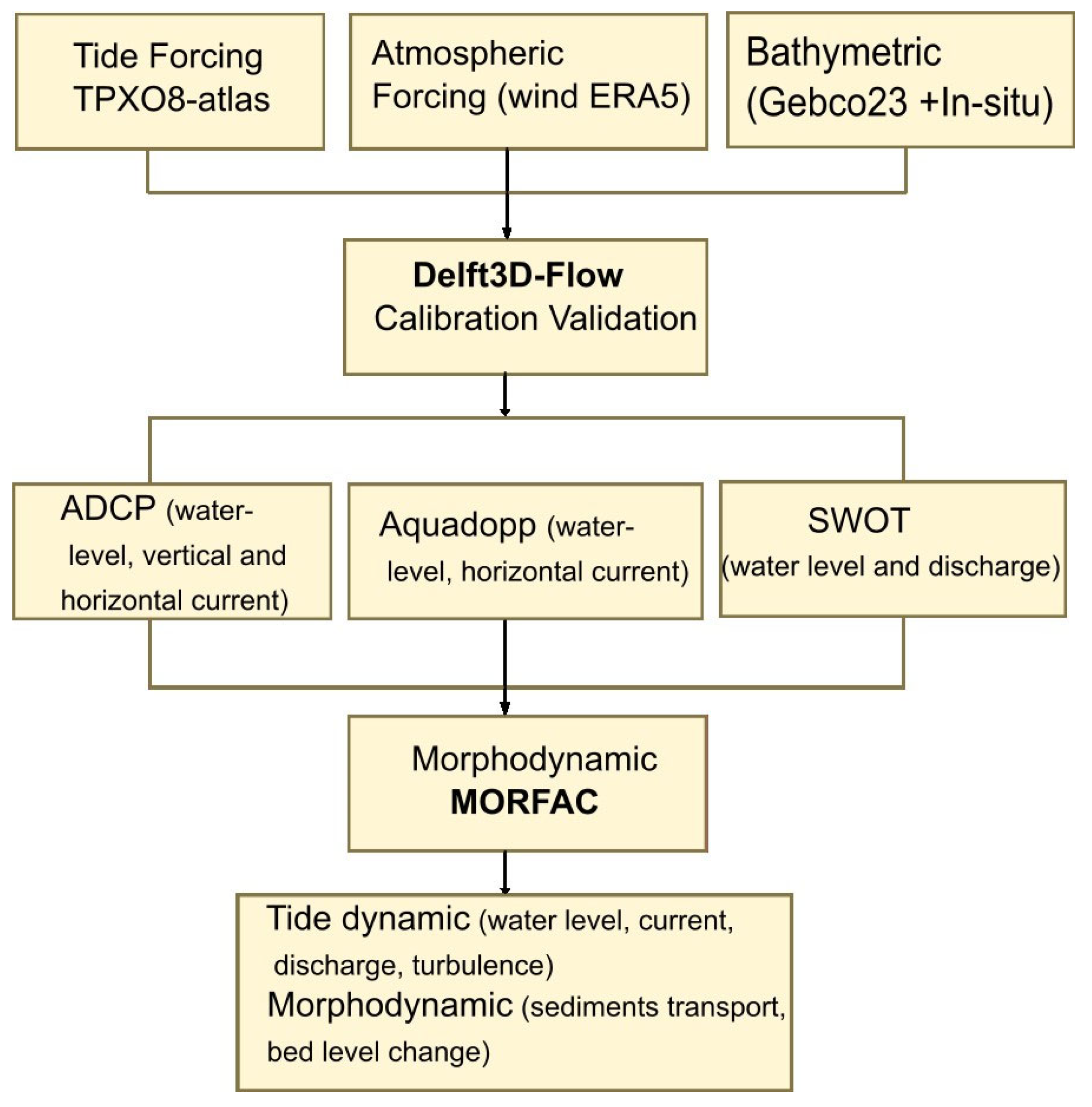

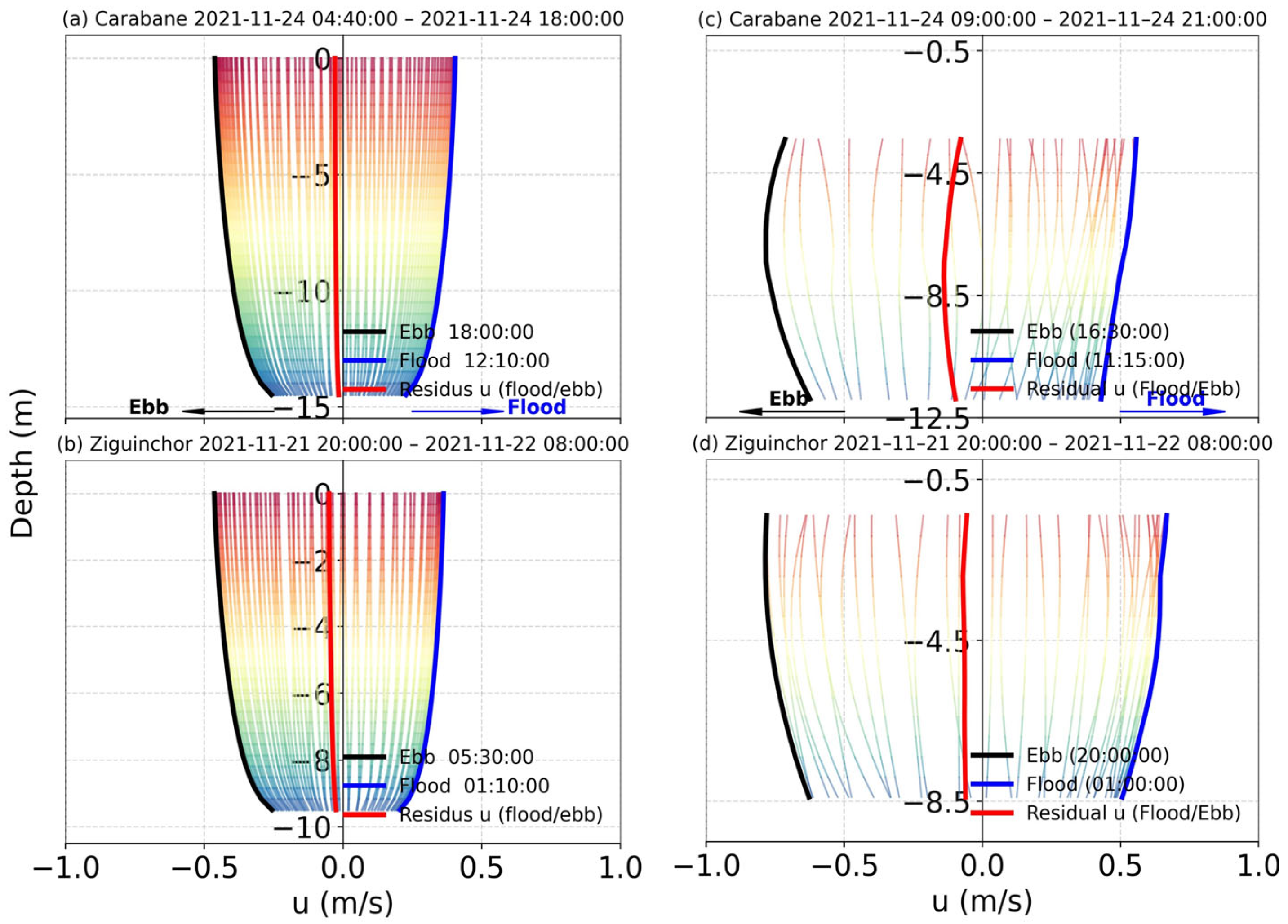
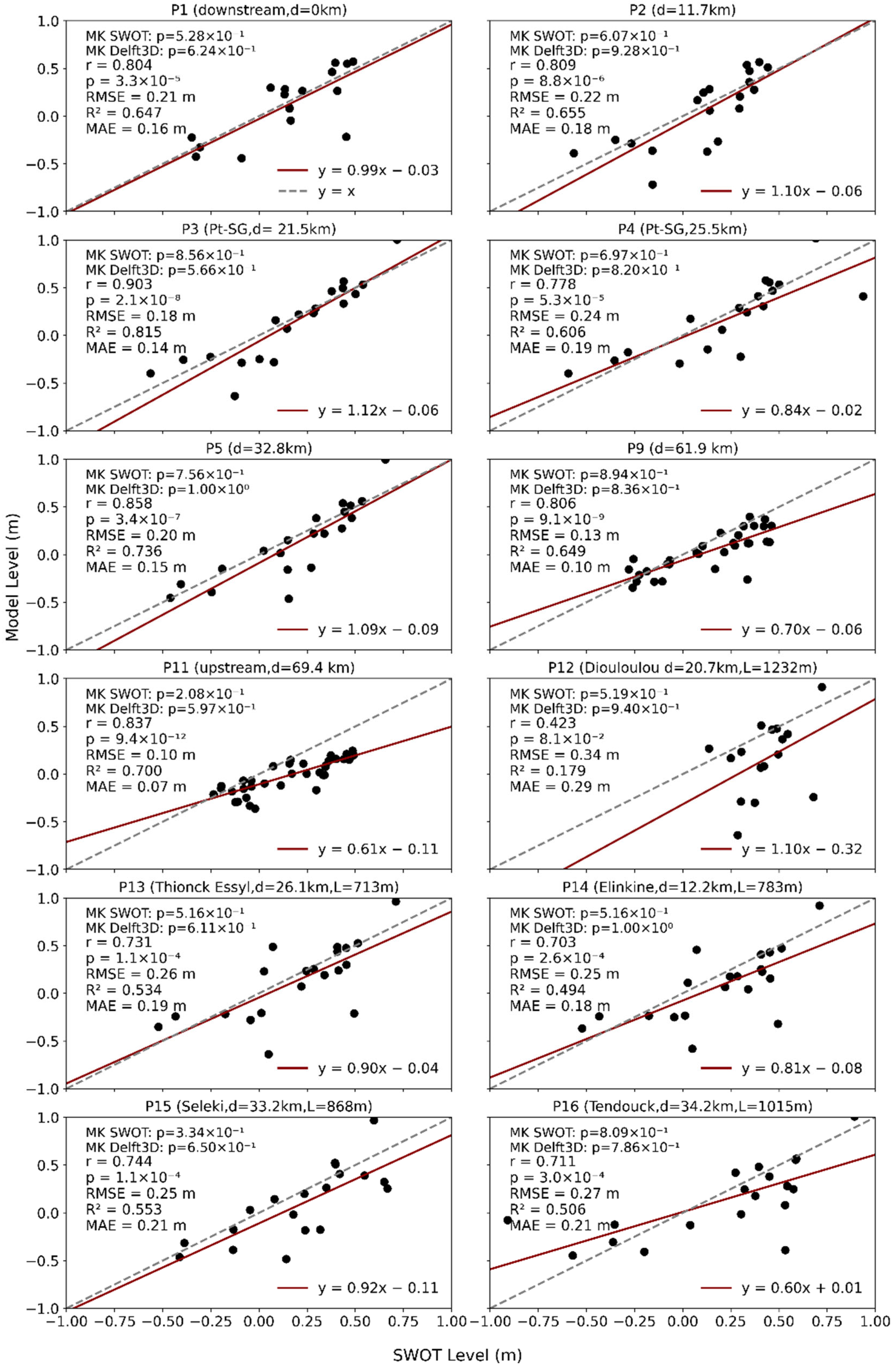
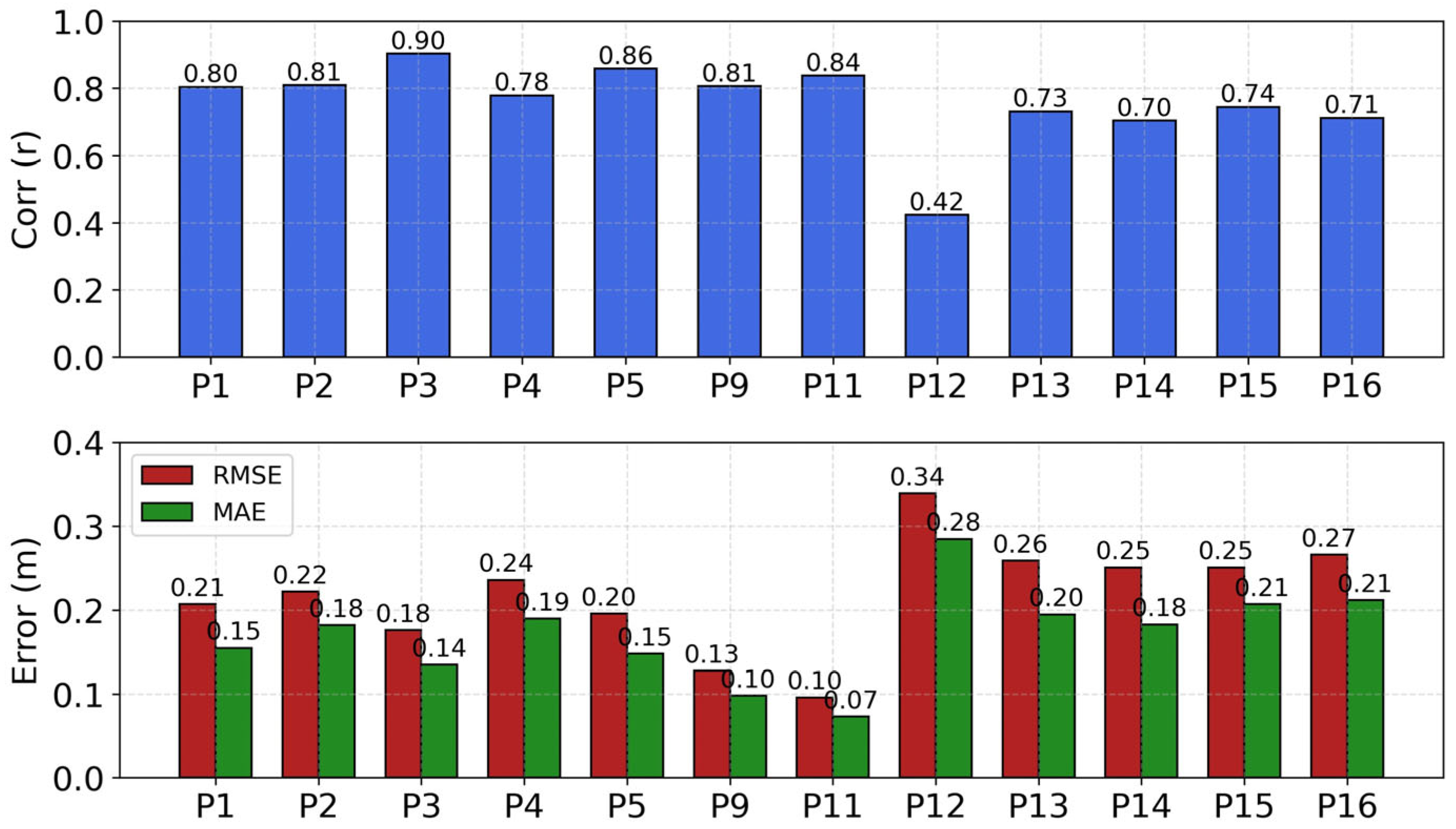

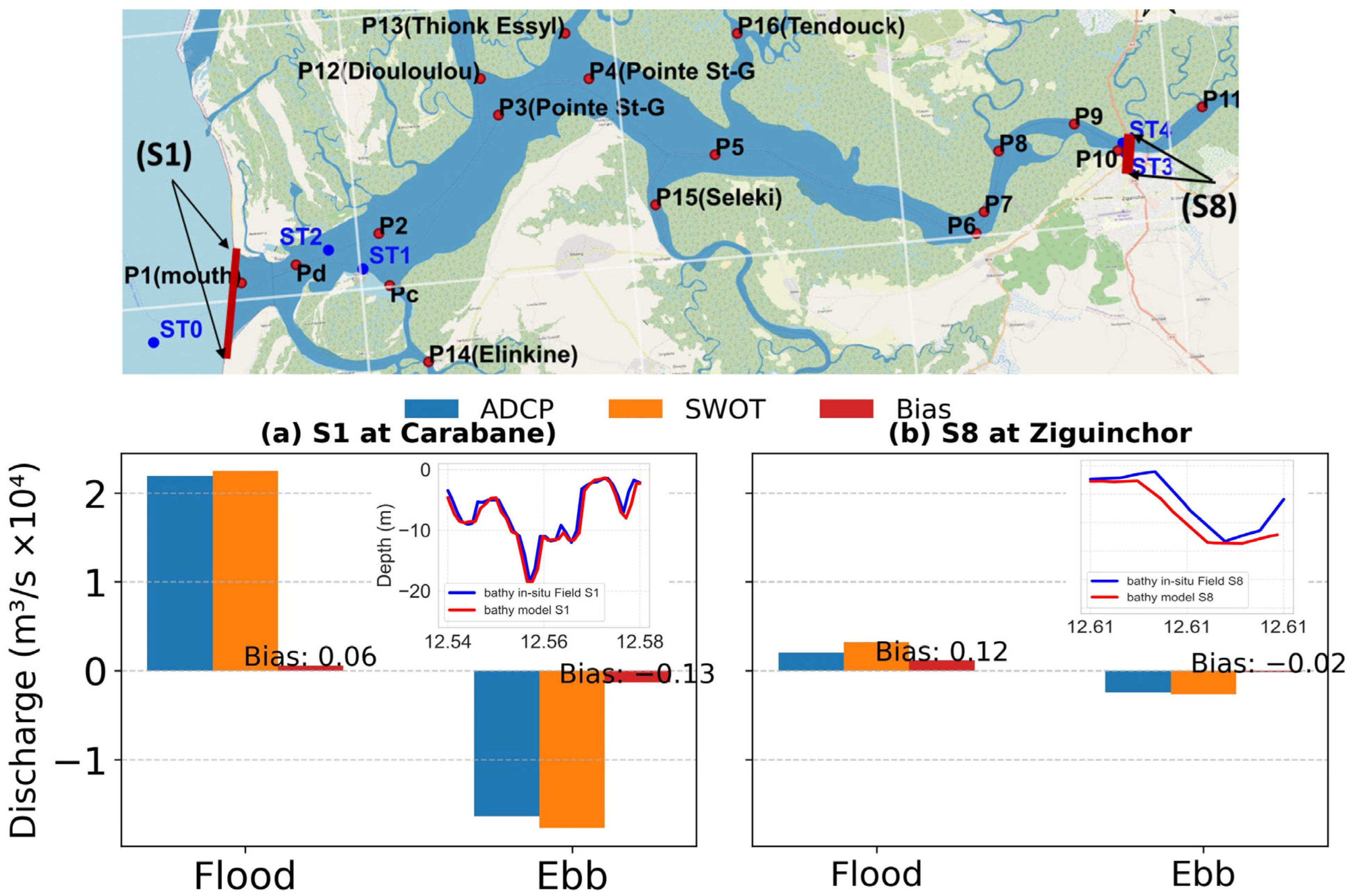
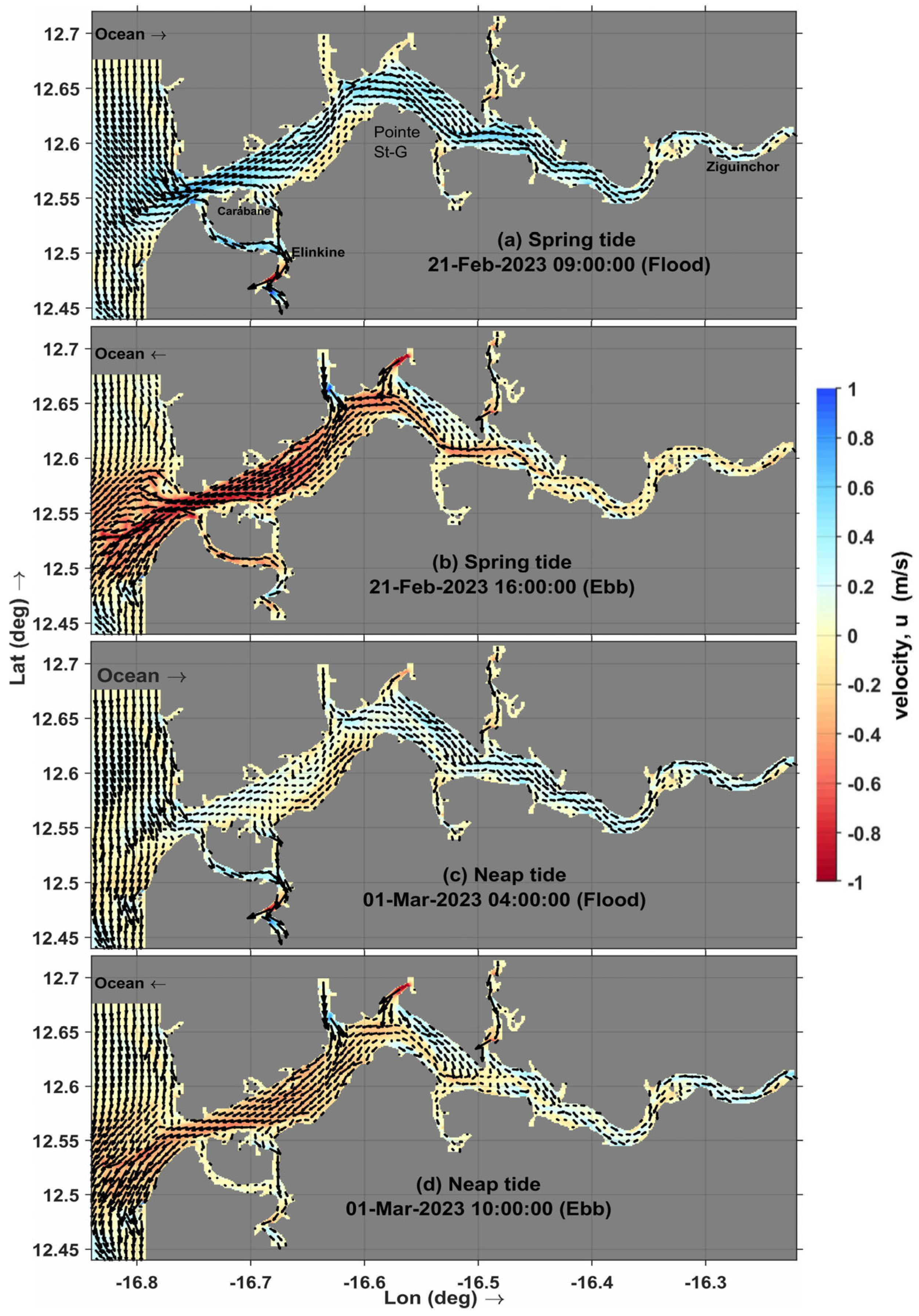


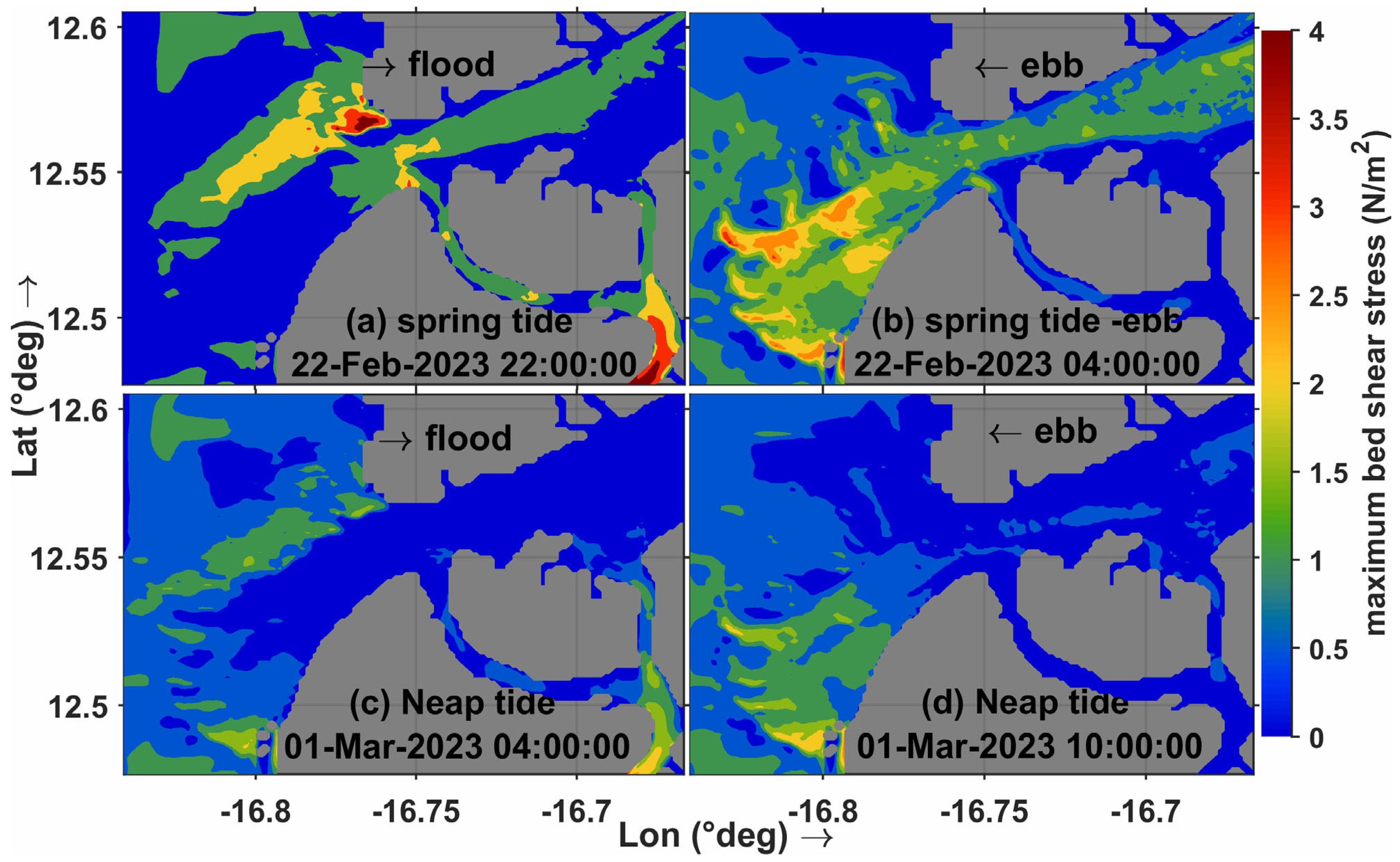
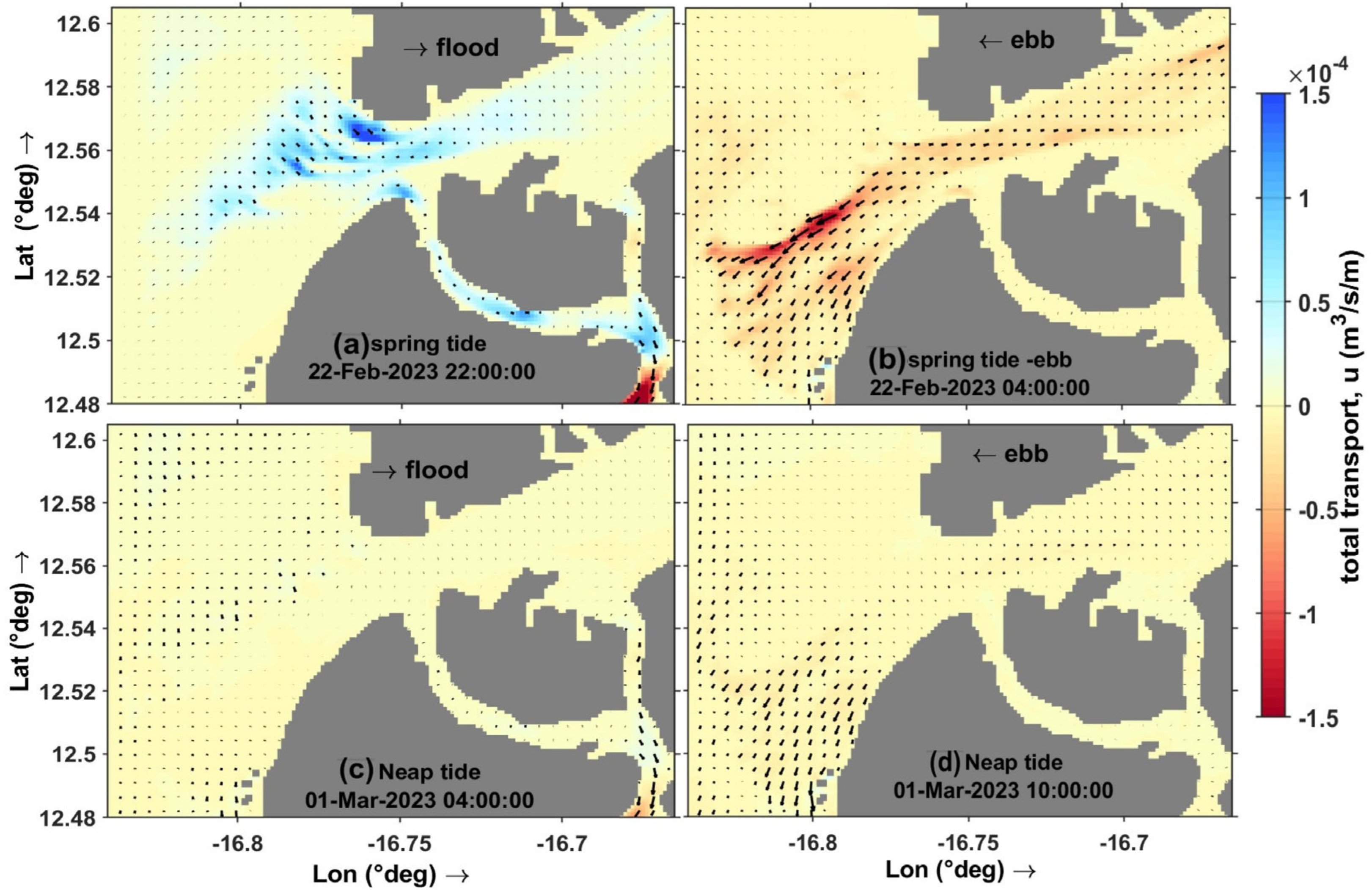
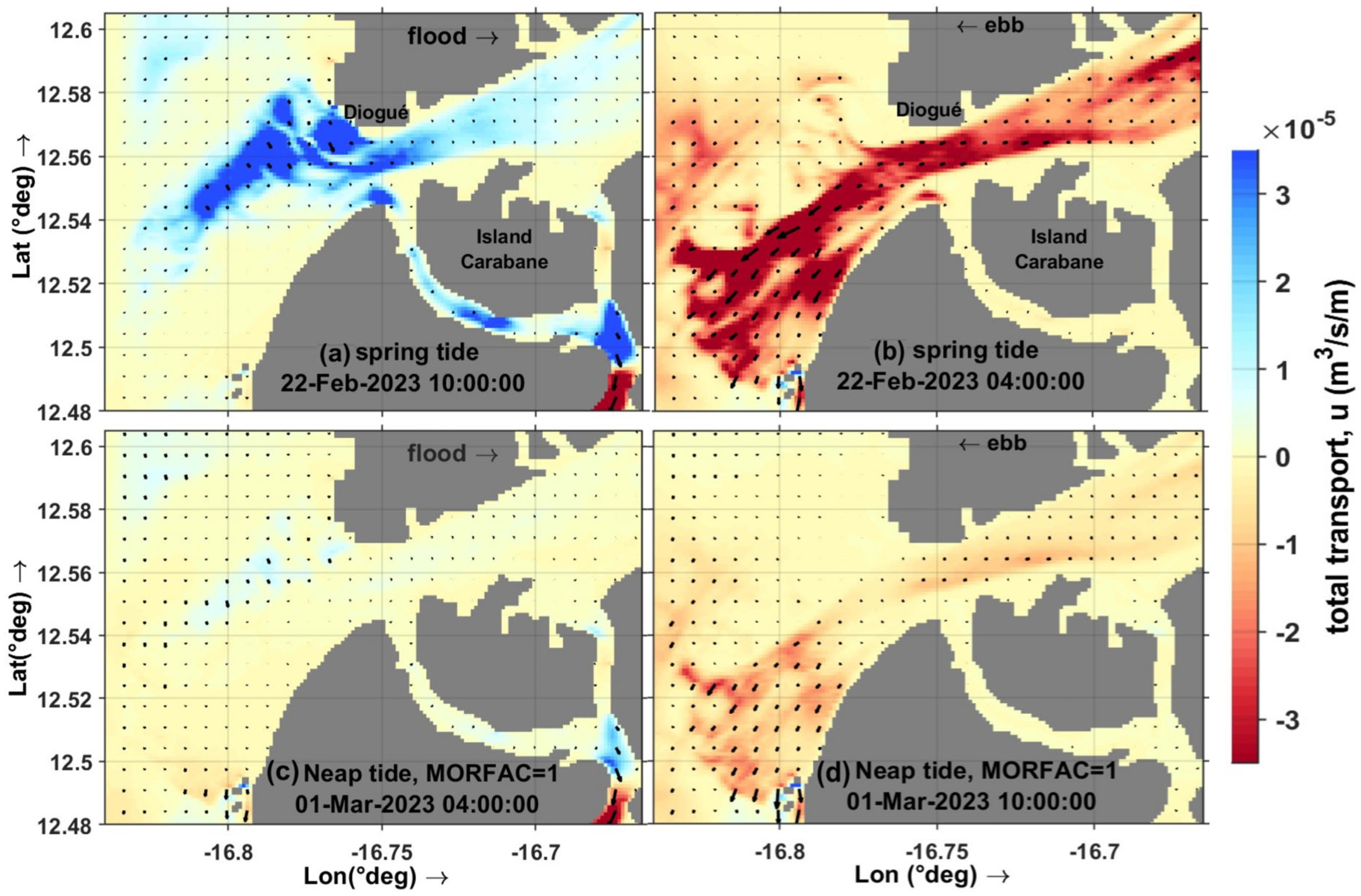

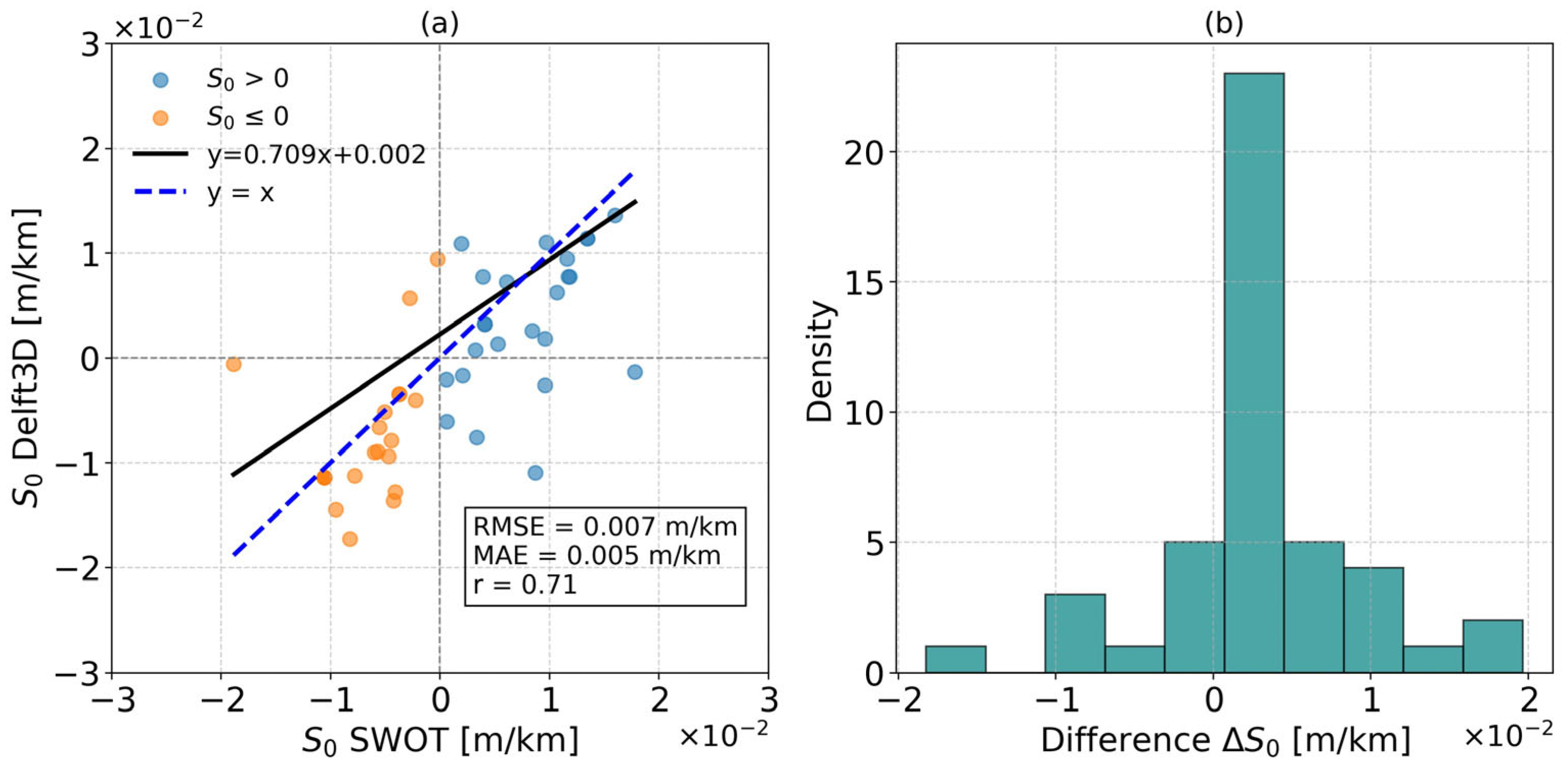
| Stations | Correlation (R) | Slope | SWOT Trend | Delft3D Trend | Interpretation |
|---|---|---|---|---|---|
| P1 | 0.804 | 0.99 | Not Significant (NS) (p-value > 0.05) | NS(p-value > 0.05) | Good agreement between observed and simulated |
| P11 | 0.837 | 0.61 | NS(p-value > 0.05) | NS(p-value > 0.05) | Underestimation of amplitude in the model |
| P12–P16 | 0.42–0.74 | 0.60–1.10 | NS(p-value > 0.05) | NS(p-value > 0.05) | Weak signal; model performance requires improvement |
| P2–P9 | >0.80 | ~1.0 | Mixed (often NS) | NS to strongly stable | Good alignment; little to no trend observed |
Disclaimer/Publisher’s Note: The statements, opinions and data contained in all publications are solely those of the individual author(s) and contributor(s) and not of MDPI and/or the editor(s). MDPI and/or the editor(s) disclaim responsibility for any injury to people or property resulting from any ideas, methods, instructions or products referred to in the content. |
© 2025 by the authors. Licensee MDPI, Basel, Switzerland. This article is an open access article distributed under the terms and conditions of the Creative Commons Attribution (CC BY) license (https://creativecommons.org/licenses/by/4.0/).
Share and Cite
Diouf, A.; Salameh, E.; Sakho, I.; Sow, B.A.; Deloffre, J.; López Solano, C.; Turki, E.I.; Lafite, R. Use of SWOT Data for Hydrodynamic Modelling in a Tropical Microtidal Estuarine System: The Case of Casamance (Senegal). Remote Sens. 2025, 17, 3252. https://doi.org/10.3390/rs17183252
Diouf A, Salameh E, Sakho I, Sow BA, Deloffre J, López Solano C, Turki EI, Lafite R. Use of SWOT Data for Hydrodynamic Modelling in a Tropical Microtidal Estuarine System: The Case of Casamance (Senegal). Remote Sensing. 2025; 17(18):3252. https://doi.org/10.3390/rs17183252
Chicago/Turabian StyleDiouf, Amadou, Edward Salameh, Issa Sakho, Bamol Ali Sow, Julien Deloffre, Carlos López Solano, Emma Imen Turki, and Robert Lafite. 2025. "Use of SWOT Data for Hydrodynamic Modelling in a Tropical Microtidal Estuarine System: The Case of Casamance (Senegal)" Remote Sensing 17, no. 18: 3252. https://doi.org/10.3390/rs17183252
APA StyleDiouf, A., Salameh, E., Sakho, I., Sow, B. A., Deloffre, J., López Solano, C., Turki, E. I., & Lafite, R. (2025). Use of SWOT Data for Hydrodynamic Modelling in a Tropical Microtidal Estuarine System: The Case of Casamance (Senegal). Remote Sensing, 17(18), 3252. https://doi.org/10.3390/rs17183252







